转移背阔肌肌皮瓣在局部晚期乳腺癌手术
50 例乳腺癌患者改良根治即时背阔肌肌皮瓣辅助重建垣扩张器植入术的手术配合

作者单位:210000 南京市 江苏省妇幼保健院严丽洁:女,本科,主管护师通信作者:潘有蓉50例乳腺癌患者改良根治即时背阔肌肌皮瓣辅助重建+扩张器植入术的手术配合严丽洁 潘有蓉 冯建萍doi :10.3969/j.issn.1672-9676.2016.18.053 乳腺癌已成为严重威胁女性健康的恶性肿瘤之一,是我国女性发病率最高的恶性肿瘤[1],严重影响妇女身心健康甚至危及生命。
手术治疗是当前乳腺癌患者的主要治疗手段,而乳房是女性的第2性征器官,失去乳房不但躯体形象下降,而且影响女性特征[2]。
近年来,在乳腺癌改良根治术的基础上,对患者行即刻背阔肌肌皮瓣乳房重建术,既可保留原有手术的效果,又能基本恢复患者乳房形体,对女性重建自我形象有很大帮助[3]。
现将我院乳腺癌改良根治术即时背阔肌肌皮瓣乳房再造+扩张器植入术的护理配合方法及体会报道如下。
1 资料与方法1.1 临床资料 选取2014年3月~2016年3月我院收治乳腺癌行乳腺癌改良根治即时背阔肌肌皮瓣辅助重建+扩张器植入术100例患者为研究对象。
均为女性,年龄25~55岁,中位数年龄35岁。
发病部位:左侧30例,右侧20例。
手术时间4~7h。
出血量20~50ml。
100例手术完全成功。
1.2 手术方法 (1)切除乳腺及清扫腋淋巴结。
以患侧乳头为中心,环乳晕弧形并向两端延长切口,切口长约20cm,电刀游离皮瓣,厚度约6mm,向上至锁骨下缘,向下至肋弓上缘,向内至胸骨旁,向外至背阔肌前缘。
从胸大肌上完整剥离乳腺组织及胸肌筋膜。
打开喙锁筋膜,暴露腋静脉,结扎并切断腋静脉分支,保留胸长、胸背神经及血管,清扫腋窝淋巴脂肪组织,除去标本,探查周围组织未及明显肿块,彻底止血。
(2)患者变换体位,改健侧卧位,供瓣区切口,长约20cm,沿左腋后线,显露背阔肌前缘,沿背阔肌表面脂肪组织层次内分离背阔肌脂肪瓣,向内侧分离至胸椎棘突旁,向下分离至季肋区背阔肌近腱膜组织处;再沿背阔肌内侧面显露并保护胸背动脉血管,钝性、锐性分离背阔肌与胸壁间隙,离断背阔肌的胸椎旁止点和下方腱膜处,形成约26cm ×16cm 的背阔肌脂肪组织瓣,检查远端血供良好。
乳腺癌改良根治术后背阔肌肌皮瓣Ⅰ期乳房重建围手术期护理
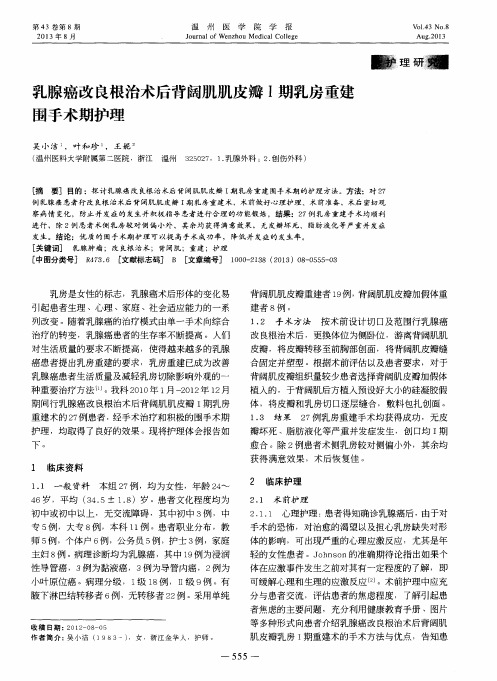
[摘 要] 目的 :探讨 乳腺癌改 良根 治术后背阔肌肌皮瓣 I期 乳房重建 围手术期 的护理方法。方法:对 27 例 乳腺 癌 患者 行 改 良根 治 术后 背 阔肌 肌 皮瓣 I期 乳房 重建 术 ,术 前 做 好 心 理 护 理 、术 前 准备 ,术后 密切观 察病 情 变化 ,防止 并发症的发生并积极指导 患者进 行合理的功 能锻炼 。结果:27例乳房重建 手术均顺利 进 行 , 除 2例 患 者 术 侧 乳 房 较 对 侧 偏 小外 , 其 余均 获得 满 意 效 果 , 无 皮 瓣 坏 死 、脂 肪 液 化 等 严 重 并 发 症 发生。结论 :优 质的 围手术期 护理 可以提 高手 术成 功率 ,降低 并发症的 发生率 。 [关键词] 乳腺肿瘤 ;改 良根 治术 ;背阔肌 ;重建 ;护理 [中图分类号] R473.6 [文献标志码] B [文章编号] 1000-2138(2013)08-0555-03
1例乳腺癌保乳手术合并背阔肌乳房重建术的个案护理

1例乳腺癌保乳手术合并背阔肌乳房重建术的个案护理乳腺癌是常见的女性恶性肿瘤,由于早期的筛查和治疗不断进步,乳腺癌患者的生存率已经得到明显提高。
保乳手术是一种常见的乳腺癌手术方式,它可以保留患者的乳房,但可能会导致乳房形态的改变。
为了解决这个问题,背阔肌乳房重建术被广泛应用于乳腺癌保乳手术后的整形手术中。
本文将探讨一例乳腺癌保乳手术合并背阔肌乳房重建术的个案护理。
1.个案介绍女性,52岁,乳腺癌患者。
经过临床检查和影像学检查,确诊为左侧乳腺癌,肿瘤直径约为2cm。
经过团队综合评估和讨论,决定进行左侧乳腺保乳手术合并背阔肌乳房重建术。
2.术前准备(1)解释手术目的、方法和风险,获得患者的知情同意。
(2)患者接受全面的术前评估,包括血常规、凝血功能、心电图和胸片等。
(3)术前依据患者的病情和手术需求进行个体化的术前准备,例如恢复营养状态、改善患者的心理状况等。
3.术中护理(1)术中监测患者的生命体征,包括心率、血压、血氧饱和度等。
(2)协助医生完成手术准备工作,如清洗患者手术部位,搬运翻身等。
(3)进一步完善手术准备,如插入导尿管、静脉通道等。
(4)提供必要的手术物品、器械,如器械包、无菌巾等。
(5)配合医生完成手术操作,如协助实施手术切口、取材、植入植物等。
4.术后护理(1)监测患者的生命体征和术后出血情况,密切观察患者的恢复情况。
(2)协助医生或切口护士处理手术切口,进行导管和引流的拔除和换药等操作。
(3)给予患者适当的镇痛和抗感染治疗,监测患者的疼痛程度和感染指标。
(4)加强术后的宣教,告知患者术后恢复和护理注意事项,如定期复查、按时服药、休息等。
(5)积极关注患者的心理需求,提供心理支持和患者教育,帮助患者应对术后身体和心理的变化。
5.随访护理(3)关注患者的心理状况,提供必要的心理支持和心理疏导。
(4)协助患者进行定期复查和检测,监测患者的生存状况和术后乳房重建效果。
(5)及时记录和报告患者的随访情况,以便于医生调整治疗方案和进一步指导患者的术后管理。
传统改良根治术与改良根治术后即刻背阔肌皮瓣乳房重建治疗乳腺癌的效果对比
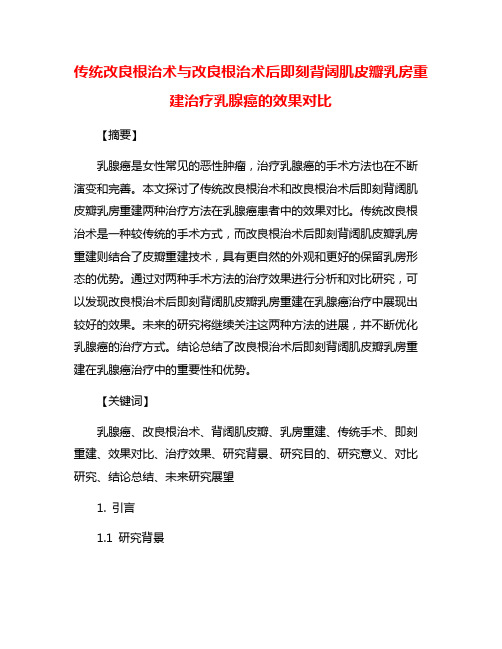
传统改良根治术与改良根治术后即刻背阔肌皮瓣乳房重建治疗乳腺癌的效果对比【摘要】乳腺癌是女性常见的恶性肿瘤,治疗乳腺癌的手术方法也在不断演变和完善。
本文探讨了传统改良根治术和改良根治术后即刻背阔肌皮瓣乳房重建两种治疗方法在乳腺癌患者中的效果对比。
传统改良根治术是一种较传统的手术方式,而改良根治术后即刻背阔肌皮瓣乳房重建则结合了皮瓣重建技术,具有更自然的外观和更好的保留乳房形态的优势。
通过对两种手术方法的治疗效果进行分析和对比研究,可以发现改良根治术后即刻背阔肌皮瓣乳房重建在乳腺癌治疗中展现出较好的效果。
未来的研究将继续关注这两种方法的进展,并不断优化乳腺癌的治疗方式。
结论总结了改良根治术后即刻背阔肌皮瓣乳房重建在乳腺癌治疗中的重要性和优势。
【关键词】乳腺癌、改良根治术、背阔肌皮瓣、乳房重建、传统手术、即刻重建、效果对比、治疗效果、研究背景、研究目的、研究意义、对比研究、结论总结、未来研究展望1. 引言1.1 研究背景乳腺癌是女性常见的恶性肿瘤之一,其发病率逐年上升,严重影响女性的身心健康。
目前,乳腺癌的治疗方法主要包括手术切除、放疗、化疗等多种综合治疗手段。
手术切除在乳腺癌治疗中起着至关重要的作用,其中改良根治术是常用的手术方式之一。
改良根治术是一种相对保守的手术方式,旨在尽可能地保留患者的乳腺组织,减少对患者的伤害。
传统的改良根治术存在一些局限性,比如手术后可能会影响患者的乳腺形态与观感,导致患者的心理负担增加。
为了解决传统改良根治术的局限性,改良根治术后即刻背阔肌皮瓣乳房重建技术逐渐被引入临床实践。
这种技术在进行乳腺癌根治手术的利用患者自身组织进行即刻重建,既可以有效保留乳腺形态,又可以改善乳腺癌患者的生活质量。
本研究旨在比较传统改良根治术与改良根治术后即刻背阔肌皮瓣乳房重建对乳腺癌患者的治疗效果,为临床提供更加有效的治疗方案。
1.2 研究目的本研究的目的在于比较传统改良根治术和改良根治术后即刻背阔肌皮瓣乳房重建治疗乳腺癌的效果,探讨两种治疗方法在乳腺癌患者中的应用价值。
乳腺癌术后乳房重建综述

乳腺癌术后乳房重建综述2内蒙古医科大学附属人民医院(内蒙古自治区肿瘤医院)乳腺外科,呼和浩特 010020#通信作者3内蒙古医科大学附属人民医院(内蒙古自治区肿瘤医院)乳腺外科,呼和浩特 010020#通信作者:梁俊青摘要:乳腺癌作为现今困扰女性的一大疾病,随着时代的变化,更多的女性开始不仅仅关注疾病的治疗,对于乳腺癌术后的乳房重建也越来越重视。
术后的修复不但影响到乳房外形的美观也关系到术后对于患者的心理影响,生活方式等。
所以现在的外科医生不但着重于疾病的治疗方案,也在术后重建中尽量满足患者对于乳房的美观要求。
乳腺癌术后乳房重建在我国尚未普及,未来需加大宣传力度,并培养专业技术人才,以提高乳腺癌患者术后生活质量,改善心理状态。
本篇综述主要介绍了乳腺癌术后重建的几种方式及术后重建对于患者的心理影响。
关键词:乳腺癌,乳房重建,心理影响前言在全世界乳腺癌已经成为女性癌症死亡的主要原因,并且占癌症总病例中的23%,癌症死亡的14%[1]。
导致乳腺癌发病的危险因素其中包括年龄不同,基因变异,内分泌代谢紊乱等。
乳腺癌最常见的原发肿瘤部位是乳房的外-上象限,其中最常见的组织学类型是导管内癌。
乳腺癌的治疗方式主要分为两大类,一是药物治疗二是手术治疗。
在手术治疗中手术方式的选择需要通过综合评估乳腺癌的分期和患者身体情况,分为保留乳房手术、全乳房切除术、根治术和扩大根治术、改良根治术。
现今的医学技术在治疗乳腺癌方面,近十年内的生存率已经超过了80%[2]。
近些年,随着乳腺癌手术治疗后生存率的升高,人们对于乳房的外形和美观程度愈加关注。
1、乳房重建的发展在1895年时Vincent Czerny首次提出乳房修复,之后乳房重建技术就被更多的人关注到[3]。
1998年在葡萄牙圣塔雷地区医院整形外科和重建外科就对99例乳腺癌患者进行了肿瘤的术后重建,大多数都是即时重建,在一定程度上极大地促进了患者术后的心理康复。
在近十年,关于乳腺治疗的外科手术方面有了明显的进展,医生会对患者进行术前各项指标的评估,并且提供患者选择最适合的手术治疗术式。
肌皮瓣在局部晚期乳腺癌创面修复中的应用

新辅助化疗后均进行 了乳腺 癌根 治性切 除术 , 手术切除范 围满意 , 术后 切缘 阴性 , 术后肌皮 瓣均存活 良好 , 一期愈
治疗 。
2 结 果
视, 它为部分患者争取到手术机会 , 但患者术 中胸壁 巨 大创 面 的修 复却 是 一 个 难 点 。我 院对 收 治 的 9例 L A B C患者进行新辅助化疗后采取根治性手术 , 术 中一
期 应用肌皮瓣 修复大 面积胸壁缺 损取得 良好 效果 , 现
报告 如 下 。 1 资料 与方 法
1 . 1 一般 资料
本科 2 0 0 9年 1 月至 2 0 1 2年 7月收治
完全缓解 2例 , 部分缓解 7例。
2 . 2 手术治疗效果 9例 L A B C患者均进行 了标准 的
L A B C患者 9 例, 年龄 4 1 ~ 6 5岁 , 中位 年龄 5 1岁 , 均为 女性 , 肿瘤最 大 8 . 0 C I T I × 5 . 8 C n l , 最小 5 . 0 c m ×2 . 6
局 部 晚 期 乳 腺 癌 患 者 新 辅 助化 疗后 进 行 乳腺 癌 根 治 术 , 且 术 中采 用 肌 皮 瓣修 复 胸 壁 巨大 创 面 是 一 种
安全 可靠 的方 法, 能极 大改善 患者 术后 的生 活质量。
【 关键词 】 局部 晚期 乳腺 癌; 肌皮瓣 ; 新辅助化疗
随着女性防癌意识的增 强及乳腺癌早期诊 断水平
广东 医学
2 0 1 3年 1 0月 第 3 4卷第 1 9期 Gu a n g d o n g Me d i c a l J o u r n a l O c t .2 0 1 3 , Vo 1 .3 4, N o .1 9
乳腺癌改良根治术后同期背阔肌皮瓣转移的手术配合

5 2 洗手 护 士要熟 悉 手 术 步 骤 , 到 配合 熟 练 , . 做 严
格 无菌操 作 。 在整个 手术 过程 中确保 器械 无菌 。
定 。背部放 置负压 引 流管 , 接拉拢 皮肤缝 合 。 直
4 8 调 整 患 者 于 平 卧 位 , 新 消 毒 铺 单 , 背 阔 肌 . 重 将
维普资讯
・
5 4 ・ 4
护士进修杂志 20 0 8年 3月 第 2 3卷 第 6期
行 , 所 需 肌 肉 多 少 切 取 背 阔 肌 肌 皮 瓣 及 其 周 围 的 按
尺 神经 的保护 , 又要 利 于手术 医生操 作 。
脂肪 组织 , 据对 侧乳 房大 小可切 取全 部背 阔肌 。 根 以 肩胛 下血管 为 蒂 , 皮 下 隧 道 转 移 到胸 部 , 时 固 经 暂
先 阅读病 历 , 了解各 项化 验结 果 , 了解 患者 的心理 再
状 况及需 求 , 手术 室健 康教 育手 册 发放给 患者 , 将 嘱 患 者认 真翻 阅 , 向病 人及 其家 属介 绍手术 室 的环境 ,
4 6 将 患 者置 于 患侧 在 上 侧 卧位 , . 重新 消 毒铺 单 , 患 侧上 肢用 无菌 单包 扎 , 于术 中 移动 。 便
4 1 患 者取 平卧 位 , 侧 上 肢 外 展 于 单后 在患侧 加铺 一条 洞单 。 常
4 2 于 患侧 乳房 根据 肿块 位置 切开 皮肤 、 . 皮下组 织 后找 到肿 块组 织 , 艾利 斯 夹持肿 块 切除后 , 中送 用 术
巡 回护 士于 手术 前 1日前 往病 房 ,
3 1 术 前访视 .
结 , 留胸 长神 经 、 背神 经 和肩 胛 下 血 管 支 , 除 保 胸 移 标本 , 4 用 3℃左 右蒸馏 水 冲洗 浸泡 创面 约 5mi n吸 净 , 口用 4 m×3 m 的手术薄 膜覆 盖 。 伤 5c 0c
乳腺癌改良根治术同期背阔肌皮瓣乳房再造术术后护理

乳腺癌改良根治术同期背阔肌皮瓣乳房再造术的术后护理【摘要】目的探讨乳腺癌根治性切除同期背阔肌皮瓣乳房再造术患者术后的护理方法。
方法对14例行乳腺癌根治性切除同期背阔肌皮瓣乳房再造术患者,术后做好切口和再造乳房皮肤血运观察及护理、引流管护理、心理护理、患侧上肢护理及功能锻炼。
结果本组除1例保留乳头者部分乳头乳晕皮肤坏死,1例出现皮下积液,经及时处理痊愈外,其余患者转移肌皮瓣与周围皮肤均为一期愈合,无明显不良并发症发生。
随访1.5年,再造乳房形态逼真,上肢功能基本正常,无局部复发及远处转移。
结论对行乳腺癌根治性切除同期背阔肌皮瓣乳房再造术患者加强术后护理是确保乳房再造肌皮瓣存活的关键。
【关键词】乳腺癌根治术;乳房再造术;背阔肌皮瓣;术后护理乳腺癌是女性常见恶性肿瘤之一,在我国占全国恶性肿瘤的7%-10%[1]。
为了提高乳腺癌患者根治切除术后的生活质量,减轻乳腺癌患者术后因“毁容”成的痛苦,我院对2008年2月至2010年6月收治的14例乳癌患者行保留乳头乳晕的乳癌改良根治术同期背阔肌移植乳房再造术,术后根据背阔肌皮瓣乳房再造术患者的需求及护理特点,采取相应的护理流程,取得良好临床效果,现报告如下。
1临床资料1.1一般资料本组14例,年龄30-51岁,平均年龄41.3。
左乳腺癌6例,右乳腺癌8例。
术前体检及彩超检查腋窝淋巴结均未有肿大征象。
术中病理检查乳头后乳腺组织、肿瘤表面切除皮肤边缘及切缘未见癌组织残留。
1.2手术方法手术在全身麻醉下进行,首先行乳房肿物切除快速冰冻活检,确诊后行保留乳头、乳晕和胸大肌、胸小肌的乳腺癌改良根治术。
该手术切口下缘沿乳晕外缘进行,剥离乳房皮瓣,于皮下切除乳腺组织,然后清扫腋窝淋巴结组织。
同时切除距肿瘤边缘1-3的肿瘤表面组织。
设计背阔肌皮瓣的形状与乳腺癌改良根治术切除皮肤的形状相同,保证乳房再造后的缝合缘均无张力。
1.3术后护理1.3.1病情观察术后给予心电监护,严密监测血压、脉搏、呼吸、体温及血氧饱和度变化,并做好记录。
乳癌术中背阔肌肌皮瓣再造乳房手术7例

断水平 , 识别特异性的病因确诊是有效治疗 的关键。④注意预
防接种疫苗或 应用 抗病 毒抗 体 , 可 能有 助于某 些病 脑 的发 这 生 。⑤如诊断为病毒性脑炎后 , 早期 采用抗病毒及 足量激素治
疗, 同时采用脱水降颅压及脑保护 、 对症 等治疗 , 样能明显改 这 善预后 。 参考文献
检查资料的综合分析; ③忽视必要的医技检查, 影像学检查结脑
C T异常率可达 8% , R 可达 8% ; 临床 上应仔细追 问有 无 7 M I 6 故
结核病家族史或接触史 , 必要时行 P D皮试或胸片等检查 。 P
25 因病 毒性脑炎大多 以头痛起病 , 始时症状 可较 轻 , 出 . 开 未
3 程芳. 老年病毒性脑炎患 者并发低钠 血症的机 制探讨 . 河南实用神
经疾病杂志 ,0 4,( )7 7 . 20 7 7 :2— 3
4 史宝海 , 齐骥 , 刘英姿 . 毒性脑 炎并心肌损害 8 例 临床分 析. 病 l 山东
医药,0 4,(4)4 . 20 1 4 :1 ( 收稿 日期 :06—1 0 ) 20 1— 3
维普资讯
・
6 6・
! 生 旦筮 鲞箜 翅 些垒
墅 蜩i Iora M r 2 0 c unl a. 0 7.Vo 4. . aJ l3 No 5
关 J 。
以下几点 解决措施 : 临床 医生必 须提 高 自身业 务素质 , ① 高度
24 目前结脑有发病率增 高的趋势 , . 因临床表现 不典型 , 易 极
小切取 , 胸壁缺损较多时 , 可切 取较 大面积的肌皮瓣 。 I2 24 肌 皮瓣 转移 与 固定 : ... 以上部 肌腱与 胸部血 管神经 束 为蒂 , 将所设计 的背 阔肌肌 皮瓣完 全分离 , 并仔 细检 查皮瓣 的
乳腺癌术后即刻转移背阔肌皮瓣乳房重建术的手术配合

Lin Shuhui,Zhong Xiaoshan,Zhang H uizhen (The Affiliated Tum or Hospital,M edical College of Shantou University,Guangdong 5 1 504 1 China)
breast reconstruction was used immediate1v after operation At the sam e tim e, .
preoperative preparation,intraoperative coordination and postoperative care
surgery.M ethods:A total of 29 cases of breast cancer patients underwent
m odified radical m astectom v。shift of part of latissim us dorsi m uscle flap for
axillary front w as full,no obvious com plications occurred;after 3 m onths the
evaluation on effect of breast reconstruction for 20 cases was weii
,
7 cases
全 科 护 理 2013年 4月 第 11卷 第 4期 上 旬 版 (总 第 283期 )
· 899 ·
乳 腺 癌 术 后 即刻 转移 背 阔肌 皮瓣 乳房 重 建 术 的手 术 配 合
背阔肌肌皮瓣在保乳术和乳房再造术中的临床应用研究

[]郑幕 白, 2 郭文彬, 实用超声 心动 图解析 与诊 断【 .北 京: M】 科学技术文献 出版社, 0 : . 2 o3 O 0 [] B A A A .P w v n l i i mycri f c0 , 3 A R H M s — ae a s oada i a tn a y sn ln r i
有创 检查 的基层 医 院诊 断疾 病 的重 要参 考 。
[ 参考文献]
【J 0 G RI H N C A E 1 D U HE A , A C R Ⅲ G , R Y E , l o — Y V G A Le a_ n t C gs v en f lr n 皿 a s t i f c o [ . m J et eh a i ew i au o l i o c u t n J A s l n i 】
F 。 00 m 能较 敏感 的反 映左心 结 构 变化 、心 V <一 .3 ms 肌肥 厚和 左心室 舒张 功能情 况 。
总之 ,心 电图P F 检查 方 法 简便 易行 ,费用 T V。
低 廉 ,便 于 掌握 且 无 创 伤性 ,与 心 脏 彩 色 多普 勒 互 补 ,可 以提 高 对 左 室 舒 张功 能 评 价 的 敏感 性 及 准 确性 ,可 作 为 无 大 型 医疗 仪 器 设 备 无 条件 开展
者 。 评 价 ( 要 )J. 中 华 心 血 管 病 杂 志 , 的 摘 [ 】
l 3. 2l: 23 99 2.
值 增 大 。虽然 P' IV的异 常标 准 目前 尚未统 一 ,但 F 其 值 <一 .3 m. 大多 数 学者 认 同。本 研 究 使用 0 m s 0 被 该 标 准 通 过对 射 血 分 数 正 常 的 原发 性 高 血 压 患 者
背阔肌肌皮瓣在乳腺癌手术中的临床应用
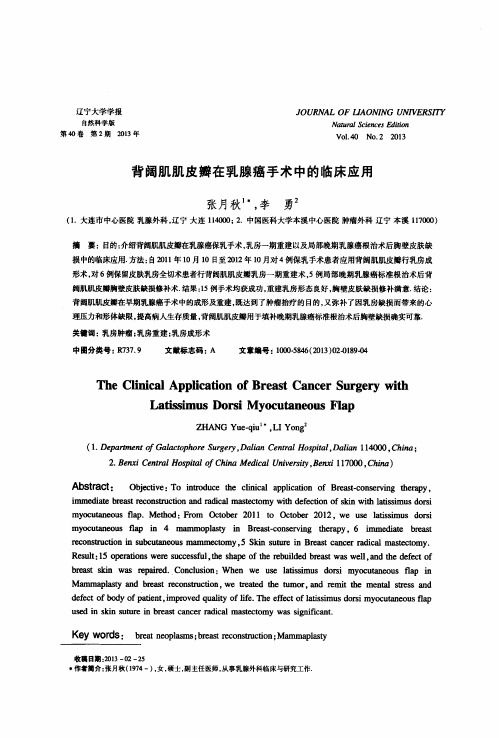
辽宁大学学报自然科学版第40卷第2期2013年J oU R N A L oF uA oN l N G U N I vE R s nl N at u r al Sci ences Edi t i onV01.40N o.22013背阔肌肌皮瓣在乳腺癌手术中的临床应用张月秋¨,李勇2(1.大连市中心医院乳腺外科,辽宁大连114000;2.中国医科大学本溪中心医院肿瘤外科辽宁本溪117000)摘要:目的:介绍背阔肌肌皮瓣在乳腺癌保乳手术,乳房一期重建以及局部晚期乳腺癌根治术后胸壁皮肤缺损中的临床应用.方法:自2011年10月10日至2012年10月对4例保乳手术患者应用背阔肌肌皮瓣行乳房成形术,对6例保留皮肤乳房全切术患者行背阔肌肌皮瓣乳房一期重建术,5例局部晚期乳腺癌标准根治术后背阔肌肌皮瓣胸壁皮肤缺损修补术.结果:15例手术均获成功,重建乳房形态良好,胸壁皮肤缺损修补满意.结论:背阔肌肌皮瓣在早期乳腺癌手术中的成形及重建,既达到了肿瘤抬疗的目的,又弥补了因乳房缺损而带来的心理压力和形体缺限,提高病人生存质量,背阔肌肌皮瓣用于填补晚期乳腺癌标准根治术后胸壁缺损确实可靠.关键词:乳房肿瘤;乳房重建;乳房成形术中圈分类号:R737.9文献标志码:A文章编号:1000-5846(2013)02-0189-04T he C l i ni cal A ppl i cat i on of B r east C anc e r Sur ger y耐t hLat i s si m us D or si M yocut aneous Fl apZ H A N G Y ue-qi uh,L I Y on92(1.D epart m ent of G al a ct ophor e S ur ge r y,D al i an C ent r al H os pi t al,D al i an114000,C hi n a;2.B enxi C e nt r al H ospi t a l of C hi na M edi cal U ni v er si t y,B enxi117000,Chi na)A bs t ract:O bj ect i ve:To i nt r oduce t he cl i ni cal appl i cat i on ofB r ea st-conse r vi ng t herapy,i m m edi at e br eas t r eco nst r uct i on and r adi cal m ast ect om y w i t h def ect i on of s ki n w i t h l at i ssi m us dor si m yocut aneous f l ap.M et hod:F r om O ct obe r2011t o O ct ober2012.w e use l at i ssi m us dor si m yocut aneous f l ap i n4m am m opl as t y i n B r ea st-conse r vi ng t her a py,6i m m edi at e br eas t r eco nst r uct i on i n subcut a neous m am m ect om y.5S ki n sut ur e i n B r ea st ca noBr r adi cal m a st ect om y.R es ul t:15ope r at i ons w er e s ucces s f ul,t he s hape of吐l e r e bui l ded br eas t W as w el l。
扩大背阔肌肌皮瓣在乳腺癌术后乳房再造中的应用体会
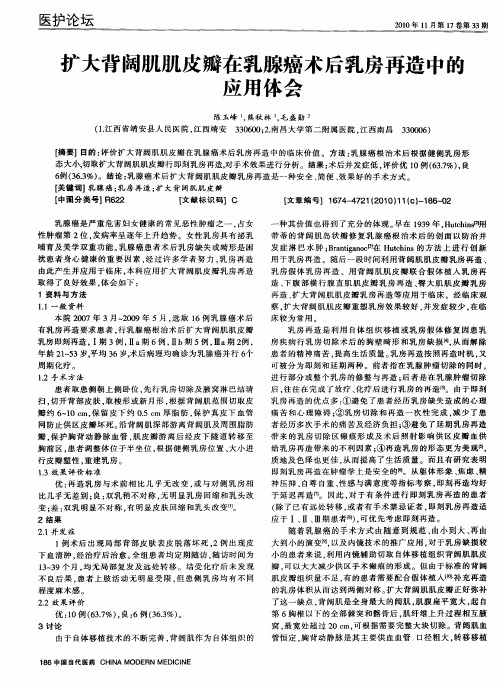
【 编号】 1 7 — 7 12 1 }1 c一 8 - 2 文章 6 4 4 2 (0 0 1 ( )1 6 0
种 其价 值 也得 到 了充分 的体 现 。 早在 13 9 9年 , thn  ̄ ] Hue is f
乳 腺癌 是严 重 危害 妇女健 康 的 常见恶 性肿 瘤 之一 , 占女
2 结 果
21并 发 症 .
患者 取患 侧朝 上侧 卧位 . 先行乳 房 切 除及腋 窝 淋 巴结 清 扫。 切开 背部 皮肤 , 取梭 形或 新月 形 , 据 背阔肌 范 围切 取皮 根 瓣 约 6 1 m, 留皮 下 约 05c 厚脂 肪 , 护 真皮 下 血管 ~ 0c 保 . m 保 网 防止供 区皮 瓣坏 死 。 背 阔肌 深部 游 离背 阔肌及 周 围脂肪 沿 瓣 , 护 胸背 动 静脉 血 管 , 保 肌皮 瓣 游离 后 经 皮 下 隧道 转 移 至 胸前 区 , 者调 整体 位于 半坐 位 , 据健 侧乳 房 位置 、 患 根 大小进
医护论 坛
20 1 第7第3 0年1 1 3 1 月 卷 期
扩 大背 阔肌肌皮瓣在乳腺癌术 后乳房再造 中的 应用体会
陈 玉 峰 , 熊秋 林 , 盛 勋 毛
(. 1江西 省靖 安县 人 民医 院 , 江西 靖安
3 0 0 ; . 昌大 学第 二 附属 医院 , 西南 昌 3 6 0 2南 江
3 00 ) 3 0 6
【 要】 摘 目的 : 价扩 大 背 阔肌肌 皮瓣 在乳 腺癌术 后 乳房 再造 中的临床 价值 。方 法 : 腺 癌 根治 术后 根 据健 侧乳 房形 评 乳
态 大小, 切取扩 大背 阔肌肌皮瓣 行 即刻 乳房再 造, 手术效果 进行分 析 。结果 : 对 术后并 发症 低 , 评价 优 1 J6 . , 0 ̄ (37 %) 良
背阔肌皮瓣转移联合假体行乳腺癌I期重建术的护理

S
·
背 阔肌 皮 瓣转 移 联 合 假 体 行 乳 腺 癌 I期 重 建 术 的护理
秦 黎 (南京 医科 大学附属常州市第二人 民医院,常州 213000)
关键词 :乳房 重建;背阔肌皮瓣 ;假体植入 ;护理 中图分 类号 :R473.6 文献标识码 :B 文章编号 :1009-8399(2014)01-0046-03
3 护理
3.1 术 前 护 理 3.1.1 心理护理 患者在确定行乳房重建术 时 ,已经 知道 自己患有乳 腺恶性 肿瘤 ,常存在 恐惧 、焦虑 、担 心 等心理问题 。责任护士应针对患者所存在 的心理问 题进行疏导 ,讲解 手术治疗 的效果 ,并可 向患者展 示硅 胶假 体的照片 ,说 明硅胶假体安全性 ,告知患者植 入假 体无 毒 、不易渗漏 、不会变形 和弹性好等优点 。患者对 手术的了解 能在一 定程度 避免或缓解乳房缺失 造成 的 心理和生理 损 害。此外 可通 过 患者 亲人 (丈 夫 、子 女 等 )与其沟 通 ,让 患者 感 受亲情 关 爱 。也 可通 过 已成 功手术的患者与其 沟通 ,增强其信心 ,使其负 面心理降 到 最 低 。 3.1.2 术前准备 ①患者入院 即完善术前 常规检查 。 如肝 、。肾功能 ,胸部 x线摄片 ,心电图 ,血 生化 ,出凝血 时间 ,血 、尿 常规 ,癌胚 抗原 、糖类 抗原 、血 清促 卵泡刺 激素 、血清促 黄体生 成素 、睾 酮 、雌兰醇 、孕酮测 定 ,乳 腺 的 B超和钼靶检查 。② 术前饮食 :癌症 是一种 消耗 性疾病 ,又 由于手术本身就是一种创伤 ,所 以术 前鼓励 患者进食高热量 、高蛋 白和高维生素的食 物 ,以补充 营 养 ,增加手术 的耐受 性。③ 手术 区皮肤 的准 备 。为 防 止术后切 口的感染 ,术 前 当天须剃 去术野 以及 后背部 供皮 区的毛发 。④禁烟 。因烟草 中的尼古丁等物质可 造成血管痉挛 ,导致血管危是我 国女性最常见 的恶性肿瘤之一 。虽然 保乳 手术 已被越来 越多 的应用 于乳腺 癌 的治 疗 ,但仍 有相 当比例 的患者 因病情必须行乳腺癌根治手术或 改 良根治手术 ,而手术导致 的乳房缺失 、腋窝 凹陷等胸部 畸形会 给乳腺癌患者带来严重 的生理和心理创 伤。乳 房 即刻再造 ,是近年来 出现 的一种新技术 ,能最大 限度 减轻 由于乳 房缺失 给患者带来 的心理创伤 。我科 自 2011年 1月_2013年 2月对 15例 乳腺癌 改 良根治术 的患者进行 了即刻 背 阔肌肌皮瓣 联合 假体充 填 ,乳 房 再造 术取得 了满意效果 ,现将护理体会报道如下 。
背阔肌带蒂皮瓣转瓣术在乳腺癌术后修复重建中的应用效果
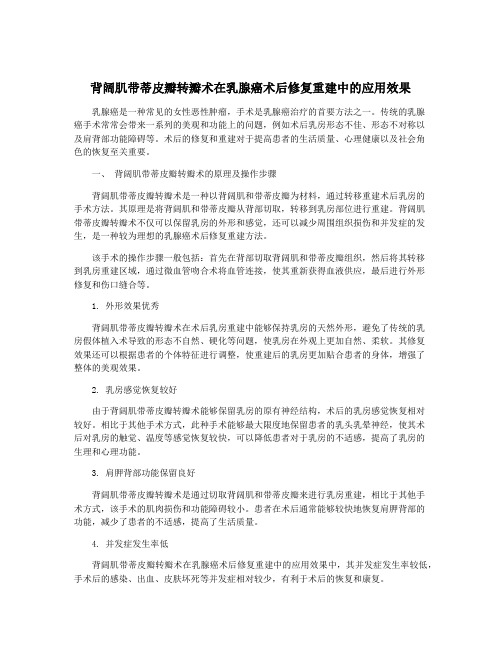
背阔肌带蒂皮瓣转瓣术在乳腺癌术后修复重建中的应用效果乳腺癌是一种常见的女性恶性肿瘤,手术是乳腺癌治疗的首要方法之一。
传统的乳腺癌手术常常会带来一系列的美观和功能上的问题,例如术后乳房形态不佳、形态不对称以及肩背部功能障碍等。
术后的修复和重建对于提高患者的生活质量、心理健康以及社会角色的恢复至关重要。
一、背阔肌带蒂皮瓣转瓣术的原理及操作步骤背阔肌带蒂皮瓣转瓣术是一种以背阔肌和带蒂皮瓣为材料,通过转移重建术后乳房的手术方法。
其原理是将背阔肌和带蒂皮瓣从背部切取,转移到乳房部位进行重建。
背阔肌带蒂皮瓣转瓣术不仅可以保留乳房的外形和感觉,还可以减少周围组织损伤和并发症的发生,是一种较为理想的乳腺癌术后修复重建方法。
该手术的操作步骤一般包括:首先在背部切取背阔肌和带蒂皮瓣组织,然后将其转移到乳房重建区域,通过微血管吻合术将血管连接,使其重新获得血液供应,最后进行外形修复和伤口缝合等。
1. 外形效果优秀背阔肌带蒂皮瓣转瓣术在术后乳房重建中能够保持乳房的天然外形,避免了传统的乳房假体植入术导致的形态不自然、硬化等问题,使乳房在外观上更加自然、柔软。
其修复效果还可以根据患者的个体特征进行调整,使重建后的乳房更加贴合患者的身体,增强了整体的美观效果。
2. 乳房感觉恢复较好由于背阔肌带蒂皮瓣转瓣术能够保留乳房的原有神经结构,术后的乳房感觉恢复相对较好。
相比于其他手术方式,此种手术能够最大限度地保留患者的乳头乳晕神经,使其术后对乳房的触觉、温度等感觉恢复较快,可以降低患者对于乳房的不适感,提高了乳房的生理和心理功能。
3. 肩胛背部功能保留良好背阔肌带蒂皮瓣转瓣术是通过切取背阔肌和带蒂皮瓣来进行乳房重建,相比于其他手术方式,该手术的肌肉损伤和功能障碍较小。
患者在术后通常能够较快地恢复肩胛背部的功能,减少了患者的不适感,提高了生活质量。
4. 并发症发生率低背阔肌带蒂皮瓣转瓣术在乳腺癌术后修复重建中的应用效果中,其并发症发生率较低,手术后的感染、出血、皮肤坏死等并发症相对较少,有利于术后的恢复和康复。
乳腺癌保乳手术后背阔肌肌皮瓣乳房缺损修补12例临床分析

【 b tat O jc v T xlr te w y o i rv gcs ec oto e ae rat osrig A src】 bef e oepoe h a f mpoi om t ucm f rbes cne n i n i t — v
s r e y M e h d F o J n ay 2 0 o Oco e 0 7,1 e l a in s w t r r ra tc n e g d ug r. to s r m a u r 0 6 t tb r2 0 f mae p t t i p i y b e s a c r a e 2 e h ma
1 临 床 分 析 2例
刘春 生 孙 建伟 贾玲 杨 净瑜 熊亮发 陈昕
【 摘要 】 目的 探 讨改善乳腺癌 保乳手术后乳房美 容效果 的方法 。方法 2 0 0 6年 1月至 2 0 07年
l 0月 , 本科对 l 年龄 为 3 2例 4~5 ( 均 3 5岁 平 9岁) 的原发性乳腺癌患者进行 了病灶局 部扩大切 除后即刻 背阔肌肌皮瓣转移整形 。然后对乳腺组织切除量 、 房 的美 容效果 及术后并 发症进 行评估 。结果 乳 乳 腺 组织切除量为 1 0~ 1 ( 1 2 5g 平均 10g 。术后乳 房美 容效 果 : 3例 , 5 ) 优 良好 6例 , 尚可 3例 , 外形差 的 无
o to n o tp rt e c mp ia in r s e s d Re u t T e w ih ft e s e i n a g d 1 0— u c me a d p s e ai o l t swe a s s e . o v c o e s ls h e g to h p cme s rn e 1
1 ae LU hnseg S N Ja —e JA ig Y NG rn —u I NG La g , C E i. 2c ss I C u — n U i w i I Ln , A gy ,X O in 和 h n i H N Xn D p r etfO cl y Fr e l’ H si l Y na r i e K n i 5 0 2 C i eat n no g , it o e S o t un nP o n , u mn 6 03 , hn m o o sP p p a o f vc g a
带蒂背阔肌皮瓣在乳房重建手术中的应用

带蒂背阔肌皮瓣在乳房重建手术中的应用史京萍南京医科大学第一附属医院江苏省人民医院红十字医院随着乳腺癌治疗模式的发展及患者观念的转变,乳房重建逐渐成为乳腺癌治疗的一部分。
背阔肌因面积较大,且蒂部解剖变异较少,同时血供丰富可被改良成不同的皮瓣,因此被认为是良好的供瓣区。
在乳房重建中,背阔肌肌皮瓣的应用较广,不仅可以使用全背阔肌或联合假体进行乳房重建,且可以根据不同的缺损范围选择合适的背阔肌皮瓣进行乳房缺损的修补。
相比单纯植入物重建,背阔肌皮瓣可获得更为良好的乳房形态且对术后放疗影响较小;相比下腹部皮瓣,背阔肌皮瓣瘢痕较短,术后恢复较快。
目前对于术后供区缝合方式的改进及辅助药物的应用,极大地降低了血清肿的发生率;腔镜技术的应用也避免了切取背阔肌皮瓣遗留的供区瘢痕。
在临床应用中,背阔肌皮瓣行乳房重建患者满意率高,术后审美效果良好,是乳房重建中一种较为优势的手术方法。
该研究总结了背阔肌皮瓣行乳房重建对并发症的控制并对近年来的手术中的问题作进一步探讨。
通信作者:史京萍(**************)原文参见:中国癌症杂志. 2017;27(8):613-619.乳腺癌是目前女性最常见的肿瘤【1】,乳腺癌外科治疗经历了扩大根治术和改良根治术的尝试和修正,其外科治疗模式已逐渐由“可以耐受的最大治疗”向“最小有效治疗”转变【2】。
在治疗效果不断改善的情况下,患者开始逐渐关注术后乳房的美学形态。
乳腺癌根治术后患者存在一定的情绪波动,保乳手术和乳房重建可一定程度改善患者术后生理、心理状态和生存质量【3】。
目前临床最普遍使用的乳房重建的方法为植入物重建和自体组织重建或自体组织合并植入物重建。
自1977年Schneider报道使用背阔肌皮瓣行乳房重建,自体组织开始应用于乳房重建,迄今背阔肌皮瓣依旧广泛应用于乳房重建。
本研究总结了背阔肌皮瓣目前临床中的应用进展。
1 背阔肌皮瓣在乳房重建中的应用1.1 解剖背阔肌位于腰背部和腋部,大部分腱膜起于第7~12胸椎和全部腰椎的棘突、骶中嵴和棘上韧带以及髂嵴的后1/3,小部分肌纤维起自肩胛下角和下3~4肋骨外侧【4】。
1例乳腺癌保乳手术合并背阔肌乳房重建术的个案护理

本次个案护理中,我们积累了以下经验和教训:
1、针对患者的具体情况,制定个性化的护理计划是关键。在术前、术中和 术后各个环节中,要充分考虑患者的需求和可能出现的问题。
2、心理护理在个案护理中具有重要地位。患者在面对乳腺癌这一重大疾病 时,往往会出现焦虑、恐惧等心理问题。我们应该给予患者充分的心理支持和疏 导,帮助他们建立信心,积极面对疾病。
患者张女士,45岁,因发现乳腺肿块到医院就诊。经过病理检查,确诊为乳 腺癌。医生建议行乳腺癌保乳手术合并背阔肌乳房重建术。张女士入院后,医护 人员对其进行了全面的检查和评估,为其制定了详细的护理计划。
手术过程分为两个步骤:首先是乳腺癌保乳手术,医生在全身麻醉下对肿瘤 进行完整切除,同时进行术中快速冰冻病理检查,确保切缘阴性;其次是背阔肌 乳房重建术,医生取下背阔肌瓣,将其移植到胸部缺损处,修复乳房形态。手术 历时5小时,术中出血量少,患者生命体征平稳。
3、严格执行无菌操作原则对于预防术后感染至关重要。在术前、术中和术 后护理中,要始终保持无菌观念,采取正确的操作方法,以减少感染风险。
4、术后疼痛管理是影响患者恢复的重要因素。对于疼痛的控制,应当采取 规范化的疼痛评估和干预措施,及时调整镇痛药物剂量和给药方式,确保患者能 够舒适地度过术后恢复期。
3、术后护理:术后给予患者疼痛护理,使用镇痛药物缓解疼痛。同时,密 切观察手术部位有无渗血、感染等迹象。在恢复期间,鼓励患者进行患侧上肢的 功能锻炼,预防患侧上肢水肿的发生。
经过精心的个案护理,张女士在术后恢复良好,未出现并发症。术后3个月, 张女士来院复查,乳房形态自然,患侧上肢功能正常。通过心理评估,发现张女 士的焦虑和抑郁状态也有所缓解。
针对张女士的病情和手术情况,我们:进行全面的心理评估,了解患者的情绪和担忧,给予心理支 持和疏导。同时,进行全面的身体检查,确保患者能够耐受手术。
扩大背阔肌肌皮瓣在乳腺癌即刻乳房再造中的应用
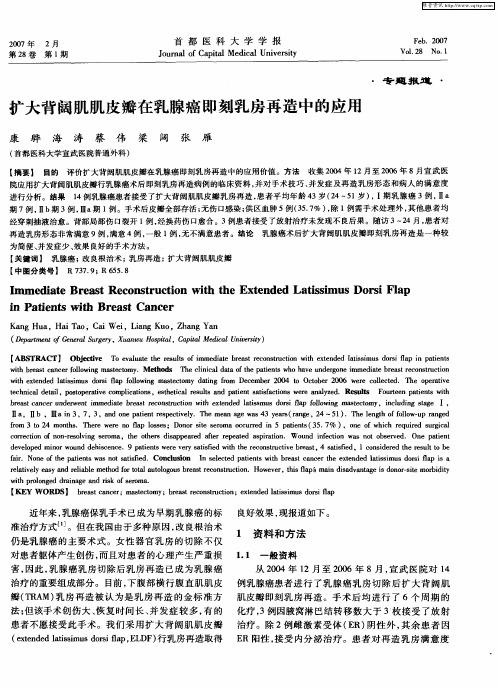
i te swih e s nc r n Pa nt t Br a tCa e i
Ka g Hua,Ha a n iT o,Ca e ,L a g Ku iW i i n o,Zh n n a g Ya
( eam n o ee l u e , un u o il Cp aMew l n e i) Dpr etfGnr r r Xaw st , ail d a U irt t aS g y H pa t vs y
期 7例 ,1 1b期 3例 , 期 I 。手 术后 皮瓣全部存活 ; 伤 口感 染 ; 区血肿 5例 ( 57 Ⅲa 例 无 供 3 . %) 除 1 , 例需 手术处理外 , 其他 患者均
经穿刺抽液治愈。背部局部伤 口裂开 1 , 例 经换 药伤 口愈合 。3例患 者接受 了放射治疗未发 现不 良后果。随访 3~ 4月 , 2 患者 对 再造乳房形态非常满意 9例 , 满意 4例 , 一般 l , 不满 意患者。结论 例 无
f m 3t 2 n s h e e ofp l ss o o sesrm cur n5pt n ( 5 7 ) n f hc eurd Sria r mot .T r w r n a o e;D n r i eo aocr i ae t 3 . % ,oeo i rq i Ugc o o4 h e e l s t d e i s w h e l
Ia I ,Ⅲai , , adoept n s ci l.,l me g a 3yas r g , 4~5 ) Ielnt fo o —prn e I ,Ib 3 7 3, n ai t ep t e Ie a aeW 4 er(a e 2 n n e r e v y 1 n s n 1 .,l e g o l wu g 1 h fl a d
- 1、下载文档前请自行甄别文档内容的完整性,平台不提供额外的编辑、内容补充、找答案等附加服务。
- 2、"仅部分预览"的文档,不可在线预览部分如存在完整性等问题,可反馈申请退款(可完整预览的文档不适用该条件!)。
- 3、如文档侵犯您的权益,请联系客服反馈,我们会尽快为您处理(人工客服工作时间:9:00-18:30)。
Caudle AS et al. Ann Surg Oncol. 2011 Apr;18(4):932-8.
转移背阔肌肌皮瓣修复术 适应症及禁忌症
适应症:
• 乳房切除术后皮肤缺 损 • 乳腺癌根治术后自体 组织乳房重建 • 保乳术后局部畸形 • 放疗后胸壁溃疡
禁忌症
• 开胸术后背阔肌被切 断 • 胸背血管受损者 • 上胸壁大面积皮肤缺 损者
Indications and complications of latissimus dorsi
myocutaneous flaps in oncologic breast surgery.
• METHODS The use of the latissimus dorsi myocutaneous flap (LDMF)
• CONCLUSIONS The use of the LDMF made wide resection of locally
advanced lesions and radionecrosis possible; major complications were rare. LDMF has its place in the armamentarium of the surgeon who regularly sees locally advanced breast cancer.
转移背阔肌肌皮瓣修复术在局 部晚期乳腺癌手术中的应用
汕头大学医学院附属肿瘤医院 乳腺中心 黄文河主任医师 huangwenhe2009@
Contents
局部晚期乳腺癌定义 局部晚期乳腺癌治疗现状 背阔肌解剖学 背阔肌肌皮瓣修复术手术要点 注意事项及临床体会
局部晚期乳腺癌定义
IIIA(T3N1M0除外)、IIIB或IIIC 期的非炎性乳腺癌
局部晚期乳腺癌 治疗现状?
发展中国家局部晚期乳腺癌治疗现状
• Locally advanced breast cancer (LABC) accounts for a sizeable number (30-60%) of breast cancer cases and is a common clinical scenario in developing countries. • Treatment of LABC has evolved from single modality treatment, consisting of radical mutilating surgery or higher doses of radiotherapy in inoperable disease to multimodality management consisting of surgery, radiation therapy (RT), chemotherapy with or without hormonal therapy. • The 5 year overall survival for mastectomy group was 67% and 80% for the BCT group. • Multidisciplinary therapy has now become the standard for women with LABC.
转移背阔肌肌皮瓣修复术 手术要点
1
• 术前先描画出手术切 口 • 全麻下,先仰卧位, 行乳腺癌改良根治或 根治术 • 乳房切口彻底止血后 用湿大纱布覆盖并用 无菌手术膜隔离
2
• 再取侧卧位,在背阔 肌表面按预先设计的 梭形切口逐层切开 • 沿背阔肌前缘切取背 阔肌并向后方延续, 注意保护前锯肌及大 圆肌 • 注意保护血管蒂 • 把肌皮瓣经皮下隧道 轻送到乳房创面
5.慎防误切大圆肌及前锯肌
前锯肌
误切上述二肌肉会引起肩关节内收功能障碍
我院乳腺中心开展转移背阔肌肌皮瓣修复术 病例资料
姓名 年龄 分期 治疗
陈XX 53Y
曾XX 66Y 李XX 47Y 张XX 37Y
Ⅲb
Ⅲb Ⅲc Ⅲb
LDMF
LDMF LDMF LDMF
临床体会
体会1
严格掌握适应症 防止并发症发生
in reconstructive breast surgery is well documented. Few reports exist of its use in oncologic breast surgery. This series describes indications and complications of the LDMF in locally advanced cancer. The records of 83 patients were analysed
背阔肌的解剖学基础
背阔肌解剖学
• 位于肩胛骨下方,三角形 • 发于T7~T12、腰骶椎和 最下面3~4根肋骨,止于 肱骨结节间沟 • 供血来源于胸背动脉和内 乳动脉及肋间动脉的穿支 • 神经支配为胸背神经 • 功能:使肱骨内旋,上臂 的内收和外展
背阔肌肌皮瓣的应用
• 历史: Baudet (1976) 首先进行了游离移植 的报道。以后临床广泛应用,成为 最常用的游离皮瓣之一 • 皮瓣特点: 血管分布恒定,蒂部管径在 1.5~2.0mm。 血管蒂长:6~8cm 易于剥离和切取 供区范围大:6~8cmX 12~15cm 供区不遗留明显的功能障碍 皮瓣血运丰富 可形成单纯的肌瓣 可用于进行肌肉功能的重建 • 应用范围: 带蒂移植:胸部、上肢的组织缺损, 屈肘功能重建,乳房再造等 游离移植:头、面、颈、四肢、躯 干等部位均可应用
2005 | Volume : 1 | Issue : 1 | Page : 21-30 Management of locally advanced breast cancer: Evolution and current practice Ashish Rustogi, Ashwini Budrukkar, Ketayun Dinshaw, Rakesh Jalali Department of Radiation Oncology, Tata Memorial Hospital, Parel, Mumbai, India
•
NCT for stage I-III breast cancer from 1994 to 2007. Chemotherapy regimens were anthracycline-and/or taxane-based as determined by the treating medical oncologist. RESULTS: Of 1,928 patients who received NCT, 1,762 (91%) had a partial or complete response, 107 (6%) had stable disease (SD), and 59 (3%) progressed (PD) while receiving at least one regimen. Of the patients with progressive disease, 40 (68%) patients underwent mastectomy, 12 (20%) underwent BCT, and 7 (12%) did not undergo surgery. In patients who underwent mastectomy, only three (8%) were BCT candidates before progression. Overall, disease progression changed the operative plan in 11 (0.5%) patients: 3 developed distant metastasis, 2 developed clinical lymphadenopathy, 3 required mastectomy instead of BCT, 2 became inoperable, and 1 required flap closure. CONCLUSIONS: Disease progression while receiving NCT is infrequent (3%), but early identification may allow for change to other, potentially beneficial, therapeutic interventions. Patients with breast cancer who receive NCT should be evaluated frequently for response to therapy. Overall, progression during NCT changes the surgical management in a small proportion of patients.
• RESULTS The indication was to cover defects caused by resection of
locally advanced breast cancer (67 cases), recurrent breast cancer (13 cases), radiation damage (2 cases), and surgical complications (1 case). The mean age of the patients was 50.2 years; 52% were postmenopausal. The flaps had mean diameters of 32 by 14 cm. The donor site was skin grafted. Clear margins were achieved in 83%. At the LDMF insertion site, wound infection required drainage in 1 case; flap necrosis required reintervention in 7 cases. In 2 cases a second skin graft was done for the LDMF donor site.
